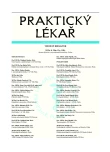Bedside assessment: urodynamic examination at a patient’s bedside
Authors:
R. Zachoval 1; V. Borovička 1; J. Krhut 2
Authors‘ workplace:
Urologické oddělení Fakultní Thomayerovy nemocnice s poliklinikou, Praha
Primář: doc. MUDr. Roman Zachoval, Ph. D.
1; Urologické oddělení Fakultní nemocnice Ostrava
Primář: MUDr. Jan Krhut, Ph. D.
2
Published in:
Prakt. Lék. 2009; 89(8): 445-446
Category:
Of different specialties
Overview
Diagnosis and treatment of incontinence in older patients with restricted mobility is often inadequate because it is difficult to evaluate. A suitable assessment technique is described in the following article.
Key words:
incontinence, bedside assessment.
Sources
1. Klingele, Ch. The urinary tract and it‘s clinical evaluation. J. Gynecol. Oncol. 2002, 7, p. 36-47.
2. Ouslander, J., Leach, G., Abelson, S. et al. Simple versus multichannel cystometry in the evaluation of bladder function in an incontinent geriatric population. J. Urol. 1988, 140, p. 1482-1486.
3. Abrams, P. Urodynamic techniques. In: Abrams, P. Urodynamics. 2nd ed. London: Springer, 1997, p. 104.
4. Berni, K. Urodynamic evaluation of the older adult: bench to bedside. Clin. Geriatr. Med. 2004, 20(3), p. 477-487.
Labels
General practitioner for children and adolescents General practitioner for adultsArticle was published in
General Practitioner

2009 Issue 8
- Memantine Eases Daily Life for Patients and Caregivers
- Metamizole vs. Tramadol in Postoperative Analgesia
- Metamizole at a Glance and in Practice – Effective Non-Opioid Analgesic for All Ages
- Memantine in Dementia Therapy – Current Findings and Possible Future Applications
- What Effect Can Be Expected from Limosilactobacillus reuteri in Mucositis and Peri-Implantitis?
Most read in this issue
- The calcium score: helper or a bad counsellor in diagnostics of chest pain suspected of coronary origin
- Prostate cancer in the age of the da Vinci robotic radical prostatectomy
- Incidence of pulmonary embolism in females aged 15–25 years in relation to oral contraception use (Results of a five-year study)
- Prevention of venous thrombosis (phlebothromboprophylaxis) in clinical practice
